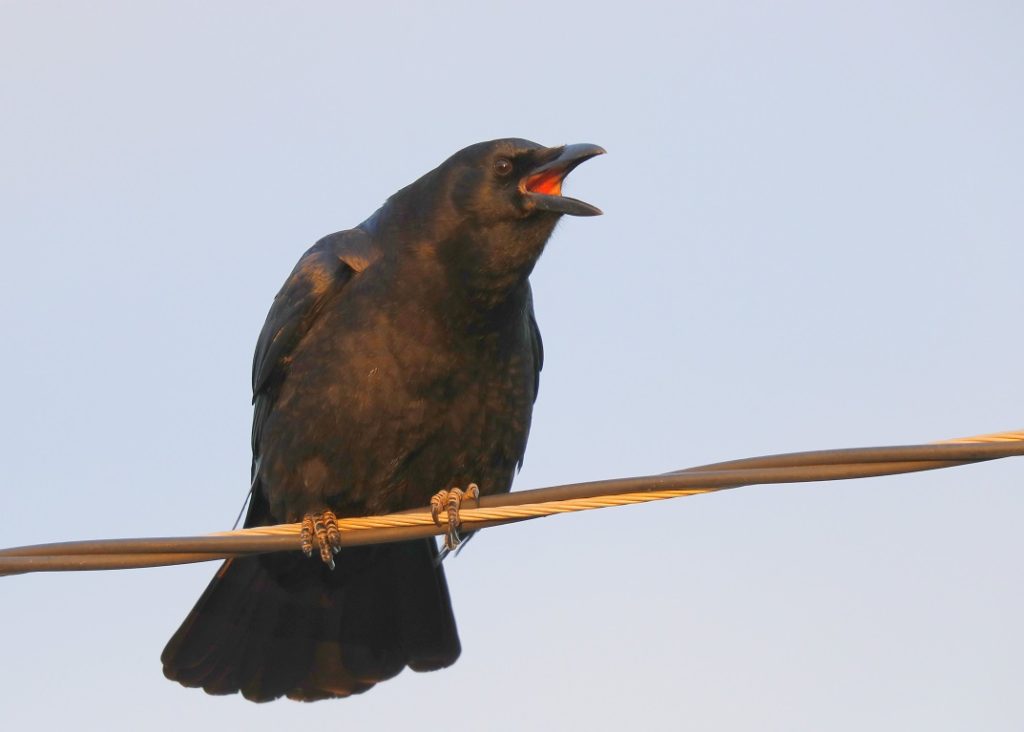
Crows © Craig Gibson
An annual late autumn phenomenon in New England is the spectacular crepuscular gathering of American Crows into large nocturnal communal roosts. Felt by many to be large, raucous, and often pesky, crows in fact are intelligent, crafty, and creative survivors in a world heavily populated with humanity. A crow aficionado ever since kidnapping a baby American Crow from a nest for a pet in my boyhood (don’t try that at home), I have been fascinated by crows. Their myriad vocalizations, their ability to count at least to three, to eat practically anything, and to survive seemingly everywhere are collectively worthy attributes. But to fully appreciate the magnificence of crows in all their glory is to observe them at a winter roost.
To dispel the erroneous perception that American Crows are sedentary residents in Massachusetts throughout the year is to visit any of the leading autumn hawk watching sites in Massachusetts from late September to early November. As autumn’s foliage is acquiring its brilliance and then falling, small groups of crows daily stream southward from northern New England and eastern Canada, some following ridge lines and valleys, others the course of major river ways or the seacoast. As fall transitions to winter these northern migrants join more southerly resident crows every evening to form what are often aggregations of many thousands of individuals. Wherever these nightly roosts happen to be, the late afternoon and nightly behavior of the crows within the roosts is a matter of considerable interest to the careful and dedicated watcher. And there are lots of unanswered questions surrounding these winter roosts.
For example one might assume that every evening crows from far and wide simply fly directly to a communal roost site for the night, or that in the morning the crows utilizing a roost might routinely head for the same daytime foraging areas. Not only are these assumptions untrue, they also offer insight into the mysteries of crow behavior. Normally relatively solitary during the mid-spring nesting season, by mid-summer crows become increasingly gregarious, and by winter they have gathered into large roosts that may contain many thousands of individuals from great distances away.

© Craig Gibson
The behavior of crows near these evening roosts is particularly curious, if not mercurial. For instance, from night to night crows approaching a roost will regularly make several pre-roosting stops (called staging areas), sometimes more than a mile from the final roost site. These short stops are generally accompanied by much raucous vocalizing, before the birds present often suddenly depart and head off to another staging site where this behavior is then repeated. This may occur several times before dark within a several mile diameter area of the final roost, and the staging areas may change location from day to day.
Finally, during deep dusk or shortly after dark, most of the birds in these staging areas will make a last and often silent flight to the ultimate roost site. Surprisingly for birds as timid and wary as crows normally are during the day, at these nighttime roosts the birds often perched on bare, leafless deciduous tree branches where it is sometimes possible to literally walk under roost tree without disturbing them – something that would be virtually impossible during the day.

American Crow © Craig Gibson
Undoubtedly a number of important functions occur in these enormous winter roosts. One is the opportunity for crows in a winter roost to “meet other crows.” Since crows do not breed in their first year after nesting, these roosts may serve as “dating bars” for un-mated immature crows to meet at the winter roost, then eventually breed for the first time in the spring with mates established in the winter roost. Similarly, first-year immature crows probably learn what it truly means to be a crow in a winter roost. They likely acquire important winter foraging skills, learn how to avoid predators and other related dangers, and how to modify the many nuances of complex crow vocabulary. While seemingly speculative, there is also good evidence to reinforce and support these concepts.
To best appreciate some of the spectacular mysteries described above, currently there are few better places in eastern Massachusetts to experience them firsthand than a huge, well established American Crow and Fish Crow roost located in the city of Lawrence. This Lawrence roost has been well described in a previous Distraction Display post.
So to appreciate one of winter’s most impressive avian spectacles, try spending a late afternoon in the months ahead near the New Balance building in downtown Lawrence adjacent to the Merrimack River and behold the sight of Licorice in the Sky for yourself.

